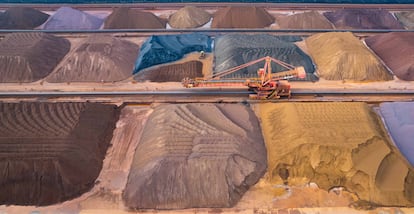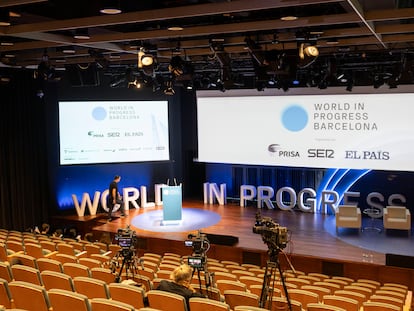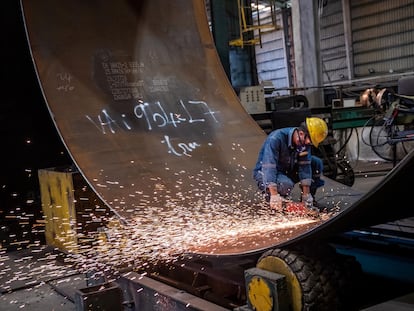Iron falls like lead: The problem facing the commodities market
The price of the metal is in decline, facing two significant challenges: signs of weakness in the Chinese economy, its largest consumer, and an excess supply

China’s appetite for raw materials is insatiable. Over the past 30 years, its remarkable growth has turned it into a massive vacuum for essential foodstuffs like soybeans, corn, and wheat, as well as metals such as copper, nickel, lithium, cobalt, and rare earths, which are vital for new technologies. Among these commodities, one stands out as the crown jewel: iron ore, essential for steel production.
Iron ore has been crucial for constructing urban housing and infrastructure, including roads, railways, sewers, and electricity generation and distribution systems. Today, China imports 75% of the world’s iron ore, purchasing between 100 and 120 million tons per month — enough to build approximately 2,000 Empire State Buildings. Consequently, during times of economic boom, demand for this metal surges due to growth in the real estate and construction sectors. However, in times of slowdown, like the current situation, consumption declines, leading to a drop in prices globally.
“China’s capacity for generating growth through construction has reached its limit, as millions of vacant units have led to declining prices and increased the risk of a prolonged downturn in the property market,” says Ole Hansen, head of commodity strategy at Saxo Bank. This situation has resulted in weakened demand for steel, subsequently reducing the appetite for iron ore, even as mining companies ramp up their production capacity.
In the first week of October, the price of a metric ton of iron ore was fluctuating between $90 and $100, which is 50% lower than its peak of $212 in the summer of 2021. “It is one of the worst-performing commodities so far this year, with prices down around 30%,” adds Ewa Manthey, a commodity expert at ING.
Before China opened up its economy, the iron ore market was relatively stable, notes Stephen Hare, an expert at Oxford Economics. “However, the price of this raw material surged in the early 21st century, outpacing other commodities as the Asian giant industrialized rapidly and urbanization accelerated,” he explains. Demand for iron ore in Beijing has increased by more than 900% since the mid-1990s, while consumption of copper and coal has grown at less than half that rate, according to Bloomberg.
This growing appetite for iron ore has been a driving force behind the development of mining giants. Companies such as Australia’s Fortescue and Rio Tinto — the largest iron ore miner in the world — as well as Brazil’s Vale and Anglo-Australian BHP have all bolstered their profits and expanded into other metals, thanks to the substantial earnings generated from iron ore sales.
Now, however, these companies are also feeling the effects of the slowdown. From January to early September, their shares have dropped between 11% and 35%. Despite this, profits remain substantial. For instance, Vale’s production cost at the end of 2023 was $20.80 per metric ton, providing ample room for continued profit generation. However, the landscape is challenging. “The combination of robust supply, like what we are experiencing now, and slowing demand can exert additional downward pressure on prices,” warns Hansen.
At the beginning of the year, there was a noticeable oversupply in the market, which has become increasingly evident throughout the year. For example, BHP and Vale reported record extraction volumes in the first half of the year, while stocks of iron ore continue to accumulate at Chinese ports.
“We expect iron ore prices to continue declining over the next five years, driven by new production and an economic slowdown in China,” says Stephen Hare from Oxford Economics. A similar imbalance occurred during 2015-16, when prices plummeted to $50 per ton. “Our current forecast does not predict prices dropping to that level, as miners are likely to adjust supply to prevent such a steep decline,” Hare added.
“However, the long-term outlook for iron ore is bleak,” noted Bill Weatherburn, a commodities economist at Capital Economics. He explained that demand from China will continue to decline as property construction contracts and decarbonization efforts lead to a greater proportion of steel production from electric arc furnaces, which utilize steel scrap instead of iron ore and coking coal.
Stimulus measures
For Manthey, the price of iron ore is increasingly biased downwards, given the bleak outlook for GDP development. “Looking ahead to the rest of the year, the fundamentals continue to point downwards. The prolonged crisis in China’s property market shows no signs of bottoming out,” she states. New housing construction in the country has plummeted by more than 20% so far this year. “Without further stimulus measures, there is little hope for a near-term recovery in the construction sector,” she adds.
Additionally, global industrial production has been subdued this year, particularly in advanced economies, according to Hare. “Central bank rate-hiking cycles have weighed on steel-consuming sectors of the economy.”
Despite this challenging scenario, the experts do not foresee a severe crisis in the iron ore market. Industries in developed and some emerging economies will continue to demand this resource. Even China, which is expected to reduce its consumption of long steel (used in construction), will still require raw materials to support its transition to a green economy. “The market will remain focused on economic data from China for signs of recovery, while economic weakness in Europe, particularly in Germany, continues to be a concern,” Hansen notes.
From a geopolitical perspective, a possible victory for Donald Trump in the upcoming U.S. elections could lead to an increase in tariffs on imports, affecting global growth and iron ore prices. Conversely, the new monetary phase characterized by interest rate cuts in the U.S. could alleviate some of these risks and stimulate growth, especially in emerging markets. However, the future remains uncertain.
Sign up for our weekly newsletter to get more English-language news coverage from EL PAÍS USA Edition
Tu suscripción se está usando en otro dispositivo
¿Quieres añadir otro usuario a tu suscripción?
Si continúas leyendo en este dispositivo, no se podrá leer en el otro.
FlechaTu suscripción se está usando en otro dispositivo y solo puedes acceder a EL PAÍS desde un dispositivo a la vez.
Si quieres compartir tu cuenta, cambia tu suscripción a la modalidad Premium, así podrás añadir otro usuario. Cada uno accederá con su propia cuenta de email, lo que os permitirá personalizar vuestra experiencia en EL PAÍS.
¿Tienes una suscripción de empresa? Accede aquí para contratar más cuentas.
En el caso de no saber quién está usando tu cuenta, te recomendamos cambiar tu contraseña aquí.
Si decides continuar compartiendo tu cuenta, este mensaje se mostrará en tu dispositivo y en el de la otra persona que está usando tu cuenta de forma indefinida, afectando a tu experiencia de lectura. Puedes consultar aquí los términos y condiciones de la suscripción digital.
More information
Archived In
Últimas noticias
The new victims of the Republican war on Obamacare: Millions hit by soaring health insurance premiums
A country divided on migrant rights: Some US states expand protections while others restrict them
Venezuela authorizes the release of another 87 political prisoners
There is as much life left to discover on planet Earth as that which is already known
Most viewed
- David King, chemist: ‘There are scientists studying how to cool the planet; nobody should stop these experiments from happening’
- Reinhard Genzel, Nobel laureate in physics: ‘One-minute videos will never give you the truth’
- Oona Chaplin: ‘I told James Cameron that I was living in a treehouse and starting a permaculture project with a friend’
- Sinaloa Cartel war is taking its toll on Los Chapitos
- The Interoceanic Train, the Mexican alternative to the Panama Canal











































